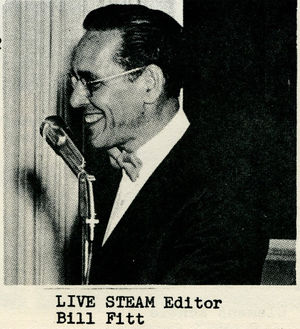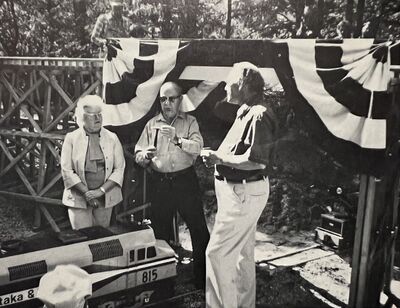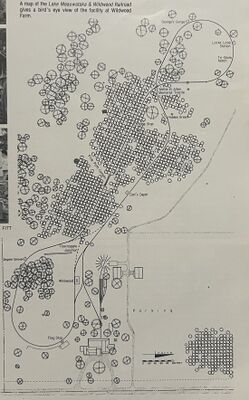William Fitt: Difference between revisions
Jump to navigation
Jump to search
| Line 21: | Line 21: | ||
: Horace's [[Whysall Light Railway]] in Bloomfield Hills, Michigan had about 1200 feet of track that ran from Woodward Avenue back along his property line for a ways before swinging off to the opposite side of his property, down a hill, across a little creek at the bottom of a valley and then back up the other side of the valley to the North property line again. It was an out-and-back operation: running backwards on the "out" run and heading back, locomotive-first, on the return trip. Part way down the hill on the first return run, a cow meandered across the track just ahead of the engine and slowed us enough to cause a stall on the up-grade. | : Horace's [[Whysall Light Railway]] in Bloomfield Hills, Michigan had about 1200 feet of track that ran from Woodward Avenue back along his property line for a ways before swinging off to the opposite side of his property, down a hill, across a little creek at the bottom of a valley and then back up the other side of the valley to the North property line again. It was an out-and-back operation: running backwards on the "out" run and heading back, locomotive-first, on the return trip. Part way down the hill on the first return run, a cow meandered across the track just ahead of the engine and slowed us enough to cause a stall on the up-grade. | ||
<gallery widths=400px heights=400px> | |||
File:DorisFitt LeoMyers BillFitt 1984.jpg|Leo Myers of Clayton, Missouri, describes the hammer made from a staybolt from the General of Civil War fame in the photo at right. Doris Fitt, Leo Myers, and Bill Fitt at the Golden Spike ceremony of the Meauwataka & Wildwood Railroad, October 1983. Paul Allen is seen on the trestle. Photo by Steve Chromik. | |||
File:LakeMeauwatakaAndWildwoodRailroad BillFitt ModeltecMay1984.jpg|Map of Bill Fitt's Lake Meauwataka & Wildwood Railroad, from Modeltec, May 1984. | |||
</gallery> | |||
== Riverside & Great Northern == | == Riverside & Great Northern == | ||
Latest revision as of 13:51, 6 August 2025
Magazines
Books
Meauwataka & Wildwood Railroad
Bill Fitt, as editor and publisher of Modeltec, wrote the following in the May 1984 edition:
- Gold Spikes are a long time in becoming reality. For the Union Pacific-Central Pacific, it took six years and four months to the day from ground-breaking ceremonies to completion. For the Lake Meauwataka & Wildwood, it took sixteen years, two-and-a-half months. The Union Pacific-Central Pacific laid 1867 miles of track; the LM&W has about 3400 feet.
- In both cases, the thinking, dreaming and planning took much more time than the actual construction. For the LM&W, the Gold Spike was the culmination of a dream that began in mid-July of 1937 when Horace Shaw, one of the pioneers in inch-and-a-half scale Live Steam, turned over the throttle of his 4-6-2 to young Bill Fitt. The Live Steam Bug bit right then and there and has never relaxed its hold!
- Horace's Whysall Light Railway in Bloomfield Hills, Michigan had about 1200 feet of track that ran from Woodward Avenue back along his property line for a ways before swinging off to the opposite side of his property, down a hill, across a little creek at the bottom of a valley and then back up the other side of the valley to the North property line again. It was an out-and-back operation: running backwards on the "out" run and heading back, locomotive-first, on the return trip. Part way down the hill on the first return run, a cow meandered across the track just ahead of the engine and slowed us enough to cause a stall on the up-grade.
Leo Myers of Clayton, Missouri, describes the hammer made from a staybolt from the General of Civil War fame in the photo at right. Doris Fitt, Leo Myers, and Bill Fitt at the Golden Spike ceremony of the Meauwataka & Wildwood Railroad, October 1983. Paul Allen is seen on the trestle. Photo by Steve Chromik.
Riverside & Great Northern
In 1988, a group of volunteers led by William C. Fitt formed the Riverside & Great Northern Preservation Society, Inc. and went to work to save the Sandley Works by turning it into a museum.


